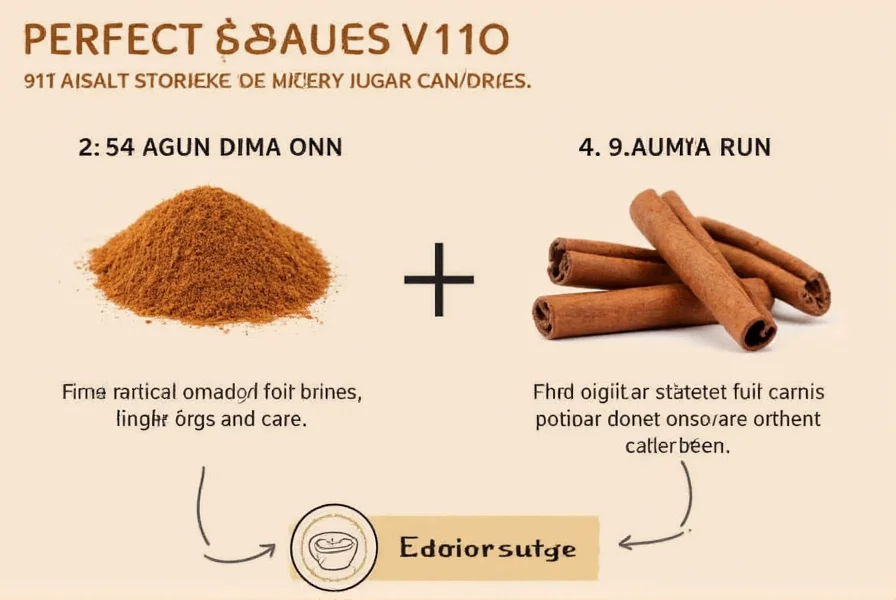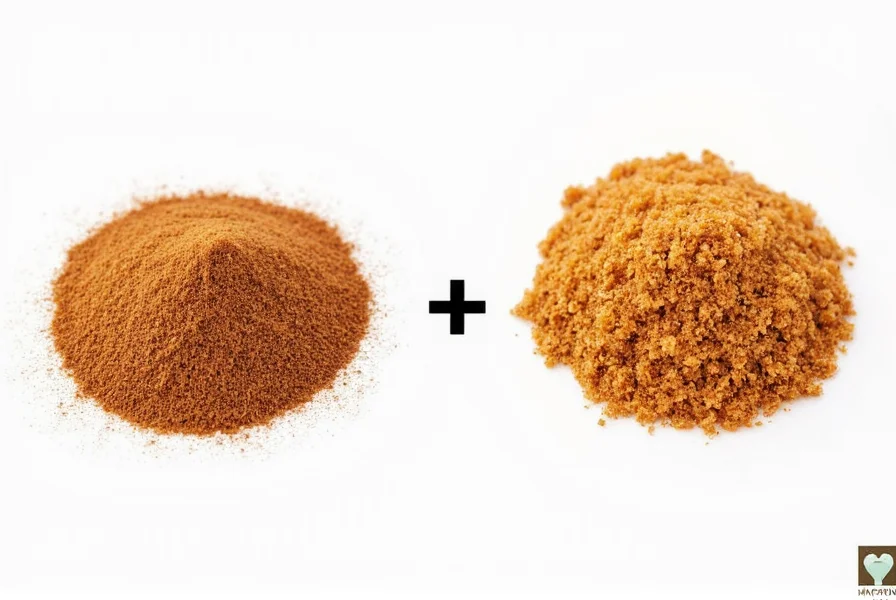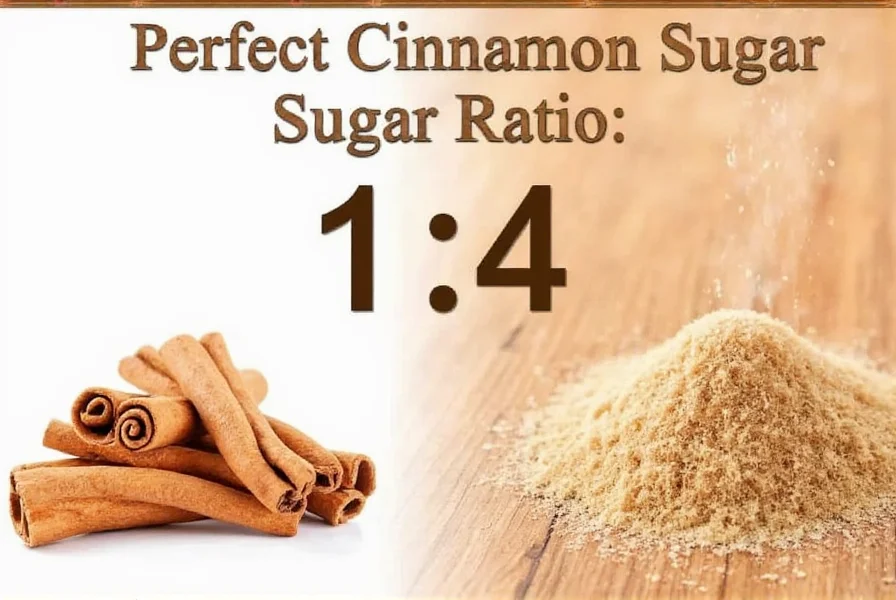The standard cinnamon sugar ratio for most baking and sprinkling applications is 1 part ground cinnamon to 3-4 parts granulated sugar (1:3 or 1:4). This classic cinnamon to sugar proportion creates a perfectly balanced mixture where the warm spice flavor complements rather than overwhelms the sweetness. Professional bakers typically recommend starting with a 1:4 ratio for general use, then adjusting to personal preference based on cinnamon strength and desired intensity.
Creating the perfect cinnamon sugar blend seems simple, but getting the ratio right makes all the difference in your baked goods and breakfast treats. Whether you're dusting cinnamon sugar on toast, filling cinnamon rolls, or coating churros, understanding the optimal proportions ensures consistent, delicious results every time.
Why the 1:4 Ratio Works Best
The 1 part cinnamon to 4 parts sugar ratio has become the industry standard for good reason. This proportion creates a mixture with just enough cinnamon to provide that signature warm, spicy aroma without making the blend bitter or overwhelming. Sugar serves multiple purposes in this mixture—it balances the cinnamon's intensity, provides texture for coating, and helps distribute the spice evenly.
Different cinnamon varieties affect the ideal ratio. True Ceylon cinnamon (often called "true cinnamon") has a more delicate, complex flavor than the more common Cassia cinnamon, which is stronger and slightly more bitter. When using Cassia (the type most readily available in supermarkets), the 1:4 ratio prevents bitterness. With milder Ceylon cinnamon, you might prefer a 1:3 ratio to achieve more pronounced flavor.
Adjusting the Cinnamon Sugar Proportion for Different Uses
Not all applications require the same cinnamon to sugar proportion. Understanding when to modify the standard ratio will elevate your culinary creations:
| Application | Recommended Ratio | Reasoning |
|---|---|---|
| General purpose (toast, oatmeal) | 1:4 | Balanced flavor that complements without dominating |
| Cinnamon rolls filling | 1:3 | Stronger cinnamon presence needed to stand out against dough |
| Churros or fried dough coating | 1:2.5 | Higher ratio compensates for some mixture falling off during frying |
| Coffee or hot chocolate topping | 1:5 | Milder flavor that dissolves better in liquids |
| Cookie or cake batter addition | 1:6 | Diluted ratio prevents spice from overwhelming other flavors |
Factors That Affect Your Ideal Cinnamon Sugar Measurement
Several variables influence which cinnamon sugar proportion will work best for your specific needs:
Cinnamon Freshness and Quality
Freshly ground cinnamon from whole sticks delivers more intense flavor than pre-ground cinnamon that's been sitting in your pantry for months. If using older cinnamon, you might need to increase the proportion slightly to achieve the same flavor impact. For the most vibrant cinnamon sugar ratio, grind your cinnamon sticks just before mixing.
Sugar Type Considerations
While granulated white sugar is standard, some recipes call for alternatives that affect the ideal ratio:
- Confectioners' sugar: Use a 1:5 ratio as it's less dense and more concentrated
- Brown sugar: Start with 1:3.5 as molasses adds its own flavor complexity
- Coarse sugar: Maintain 1:4 ratio but consider increasing cinnamon slightly for visual appeal
Personal Taste Preferences
Your perfect cinnamon sugar measurement ultimately depends on personal preference. Some people enjoy a more assertive cinnamon presence, while others prefer a subtler hint of spice. Always start with the standard 1:4 ratio, then adjust in small increments until you find your ideal balance. Keep notes of your adjustments for future reference—this is especially important if you're creating a signature recipe.
Common Mistakes to Avoid With Cinnamon Sugar Ratios
Even experienced cooks sometimes make these errors when preparing cinnamon sugar:
- Not mixing thoroughly: Simply pouring cinnamon over sugar won't create an even blend. Proper cinnamon sugar proportion requires thorough whisking or sifting to distribute the spice evenly.
- Using damp ingredients: Moisture causes clumping. Ensure both your cinnamon and sugar are dry before mixing for the most accurate ratio.
- Measuring by volume with packed cinnamon: Cinnamon compacts easily. For precise cinnamon sugar measurement, fluff your cinnamon before spooning it into the measuring spoon.
- Not adjusting for recipe context: Using the same ratio for all applications leads to inconsistent results. The ideal cinnamon to sugar proportion varies based on what you're making.
Storage Tips for Homemade Cinnamon Sugar
Properly stored, your cinnamon sugar blend will maintain its flavor and ideal ratio for months. Transfer your mixture to an airtight container away from heat and light. Glass jars with tight-sealing lids work best. For extended freshness (up to 6 months), store in the refrigerator—just be sure to bring to room temperature before using to prevent clumping.
Never store cinnamon sugar in the freezer, as moisture absorption will alter both texture and the carefully balanced ratio. If your mixture develops clumps, pass it through a fine-mesh sieve before use rather than adding more ingredients to fix it.
Creative Applications Beyond the Basics
Once you've mastered the standard cinnamon sugar ratio, experiment with these creative uses:
- Flavored rim for cocktails: Use a 1:3 ratio with superfine sugar for margarita or champagne glasses
- Yogurt or smoothie topping: Opt for a lighter 1:5 ratio to complement rather than dominate
- Homemade granola enhancement: Sprinkle with a 1:4 ratio before the final baking stage
- Buttered popcorn seasoning: Use a 1:6 ratio for subtle flavor that doesn't overwhelm
- Homemade lip scrub: Combine with coconut oil using a 1:8 ratio for gentle exfoliation
For special dietary needs, the cinnamon sugar proportion can be adapted using alternative sweeteners. When substituting erythritol or monk fruit sweeteners, maintain the 1:4 ratio but add a pinch of salt to balance the cooling effect. For stevia-based sweeteners, use a 1:10 ratio as these are significantly more concentrated.

Perfecting Your Personal Cinnamon Sugar Formula
The journey to your ideal cinnamon sugar measurement is both scientific and personal. Start with the professional standard of 1 part cinnamon to 4 parts sugar, then conduct simple taste tests:
- Prepare three small batches: 1:3, 1:4, and 1:5 ratios
- Sprinkle each on identical slices of plain toast with butter
- Note which ratio provides your preferred balance of warmth and sweetness
- Adjust in 0.25 increments until you find your perfect proportion
Document your ideal cinnamon to sugar proportion for different applications. Many professional bakers maintain a small notebook with their preferred ratios for various recipes. This ensures consistency whether you're making your famous cinnamon rolls for the holidays or just sprinkling some on your morning oatmeal.












 浙公网安备
33010002000092号
浙公网安备
33010002000092号 浙B2-20120091-4
浙B2-20120091-4